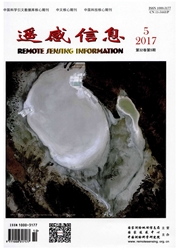

 中文摘要:
中文摘要:
分形理论由B.B.Mandelbrot于20世纪70年代中期创立,现已被广泛地应用于自然科学和社会科学的几乎所有领域。本文在前人研究的基础上,利用双毯法(Double Blanket Method)提取出图像的分形特征并用于图像分割,进一步证实了分形在此领域的可行性和有效性。首先,通过比较局部分形维数偏移全局分形维数的标准差来确定适合该方法的最优滑动窗口。其次,考虑到单尺度分维特征的局限性,提取出多尺度的特征值并建立分形维数谱。然后,以模拟图像为例,分析图像中各区域的分维谱,选择适当尺度的分形特征,利用最大似然法对图像进行分割。最后,将分形理论应用于遥感图像中,与传统的基于灰度值特征的图像分割方法相比,加入图像的空间分形纹理特征后分割精度明显提高。研究结果表明:分维值的大小和变化趋势可以表示不同地物的空间复杂度,结合地物的光谱以及灰度信息能有效地识别目标地物。
 英文摘要:
英文摘要:
Fractal method is a new subject which was founded by American scientist B. B. Mandelbrot in the middle of 1970s, which is widely applied to almost all the fields of physical and social sciences. Based on previous studies, this paper extracted the fractal features of images by using the Double Blanket Method and applied them to image segmentation which showed the validity and feasibility of fractal in this field further. Firstly, an optimum window was selected by comparing the standard error between local and global fractal dimensions. Secondly, multi-scale fractal features were extracted and fractal dimension spectrums were established with regard to single-scale's limitation. Then, by analyzing object fractal dimension spectrum, appro- priate features were utilized to simulative image segmentation based on the maximum likelihood method. At last, fractal theory was bestowed to remote sensing image. Relative to the traditional method consisted of only gray level features, the overall seg- mentation accuracy was obviously improved when considered the spatial fractal texture features. The results showed that fractal dimension and its change trend could display spatial complexity of different objects. Combined with the spectrum and gray level information, the objects can be discriminated easily.
 同期刊论文项目
同期刊论文项目
 同项目期刊论文
同项目期刊论文
 期刊信息
期刊信息
